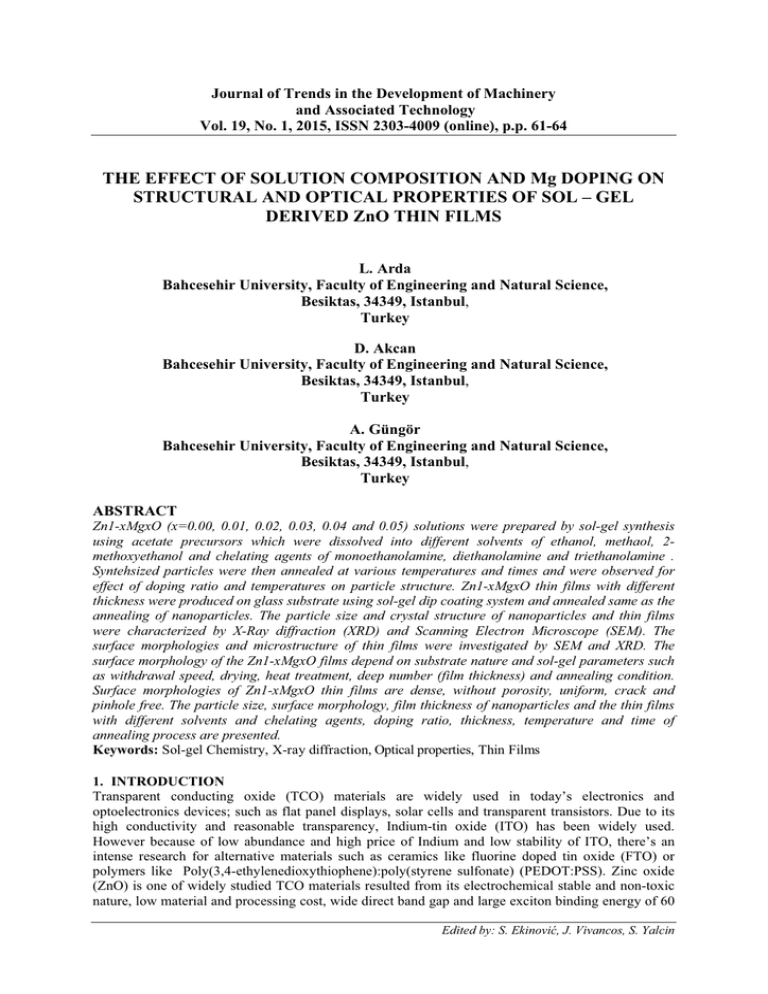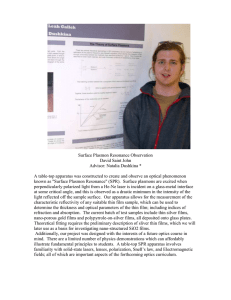advertisement

Journal of Trends in the Development of Machinery and Associated Technology Vol. 19, No. 1, 2015, ISSN 2303-4009 (online), p.p. 61-64 THE EFFECT OF SOLUTION COMPOSITION AND Mg DOPING ON STRUCTURAL AND OPTICAL PROPERTIES OF SOL – GEL DERIVED ZnO THIN FILMS L. Arda Bahcesehir University, Faculty of Engineering and Natural Science, Besiktas, 34349, Istanbul, Turkey D. Akcan Bahcesehir University, Faculty of Engineering and Natural Science, Besiktas, 34349, Istanbul, Turkey A. Güngör Bahcesehir University, Faculty of Engineering and Natural Science, Besiktas, 34349, Istanbul, Turkey ABSTRACT Zn1-xMgxO (x=0.00, 0.01, 0.02, 0.03, 0.04 and 0.05) solutions were prepared by sol-gel synthesis using acetate precursors which were dissolved into different solvents of ethanol, methaol, 2methoxyethanol and chelating agents of monoethanolamine, diethanolamine and triethanolamine . Syntehsized particles were then annealed at various temperatures and times and were observed for effect of doping ratio and temperatures on particle structure. Zn1-xMgxO thin films with different thickness were produced on glass substrate using sol-gel dip coating system and annealed same as the annealing of nanoparticles. The particle size and crystal structure of nanoparticles and thin films were characterized by X-Ray diffraction (XRD) and Scanning Electron Microscope (SEM). The surface morphologies and microstructure of thin films were investigated by SEM and XRD. The surface morphology of the Zn1-xMgxO films depend on substrate nature and sol-gel parameters such as withdrawal speed, drying, heat treatment, deep number (film thickness) and annealing condition. Surface morphologies of Zn1-xMgxO thin films are dense, without porosity, uniform, crack and pinhole free. The particle size, surface morphology, film thickness of nanoparticles and the thin films with different solvents and chelating agents, doping ratio, thickness, temperature and time of annealing process are presented. Keywords: Sol-gel Chemistry, X-ray diffraction, Optical properties, Thin Films 1. INTRODUCTION Transparent conducting oxide (TCO) materials are widely used in today’s electronics and optoelectronics devices; such as flat panel displays, solar cells and transparent transistors. Due to its high conductivity and reasonable transparency, Indium-tin oxide (ITO) has been widely used. However because of low abundance and high price of Indium and low stability of ITO, there’s an intense research for alternative materials such as ceramics like fluorine doped tin oxide (FTO) or polymers like Poly(3,4-ethylenedioxythiophene):poly(styrene sulfonate) (PEDOT:PSS). Zinc oxide (ZnO) is one of widely studied TCO materials resulted from its electrochemical stable and non-toxic nature, low material and processing cost, wide direct band gap and large exciton binding energy of 60 Edited by: S. Ekinovi, J. Vivancos, S. Yalcin meV at room temperature. Magnetic and physical properties of ZnO can be altered by various dopant materials. In addition, these properties strongly depend on production method. Various methods are employed for deposition of intrinsic and doped ZnO films. Among these methods, sol-gel process is widely used to produce ZnO films due to ease in its application like processing in room temperature and ambient atmosphere, no requirement for sophisticated equipment and simple control on stoichiometry. In present work effect of chelating agent and Mg doping on ZnO structure are investigated. ZnO and ZnO:Mg films deposited on glass substrate using sol-gel dip coating method and the effects of parameters on optical transparency and microstructure are observed. 2. EXPERIMENTAL PART In order to investigate effect of chelating agent three different solutions of Zinc Acetate Dihydrate (ZnAc, Merck) with 0.25 mol/l molar concentration in methanol prepared in ambient atmosphere. Monoethanolamine (MEA, Merck) and Triethanolamine (TEA, Merck) are added keeping ZnAc:TEA and ZnAc:MEA = 1:1 ratio and solution is stirred 8 hours for homogeneity and aging. Microscope glass slides used as substrate cleaned by first detergent and rinsed with distilled water and sonicated in concentrated sulfuric acid solution for five minutes and rinsed with distilled water again. Cleaned substrates are dipped to prepared solution using sol-gel coating system and preheated at vertical furnace of system at 400°C for 2 minutes, and once glass slides are cooled process repeated in order to obtain desired thickness. As deposition process completed glass slides are annealed in ambient atmosphere at 600°C for appropriate crystal orientation using box furnace. XRD scans were recorded using a Rigaku diffractmeter with Cu K radiation. Microstructure properties of prepared samples were observed using scanning electron microscope (SEM) (JEOL, JSM-5910LV). Optical properties of Zn1-xMgxO thin films obtained by using Shimadzu UV-mini UV-Vis-NIR spectrophotometer in 190 – 1100 nm range. 3. RESULTS AND DISCUSSION XRD analysis of the Mg doped ZnO thin films with different chelating agent (TEA, MEA and without TEA and MEA) are given in Figure 1. As seen from the figure, Mg doped ZnO films with MEA and without (TEA and MEA) are oriented along the (002) plane and all films have a hexagonal wurtzite type structure. No extra diffraction peak from Mg-related second phase is observed. XRD analysis of the Zn1-xMgxO (ZMO) (x=0.00, 0.01, 0.02, 0.03, 0.04 and 0.05) thin films with MEA are shown in Figure 2. The crystallinity of ZMO film increases with increasing Mg doping ratio. The transmittance-wavelength graph of the Mg doped ZnO thin films with different chelating agent are shown in Fig.3. According to the optical transmission spectrum, a sharp absorption is observed in the wavelength range between 360-405 nm. It is observed that the average optical transmittance is about 80% in the visible region. 62 Fig. 1. Effect of chelating agent on crystal structure. Fig. 2. Effect of magnesium doping on crystal structure. 63 Fig.3. Effect of chelating agent on optical transparency. 4. CONCLUSIONS Zn1-xMgxO thin films were coated on the glass substrate using sol-gel dip coating system. The orientation and transmittance of the ZMO thin films with MEA is higher than the ZMO thin films with TEA and without (TEA and MEA). The optical and structural properties strongly depend on the chelating agent. Acknowledgements The present work was supported by the Research Fund of Bahcesehir University. 5. REFERENCES [1] A. Gungor and L. Arda, Thickness and Temperatures Effects on Structural Properties of Mg-Doped ZnO Films by SOL-GEL Process, 11th International Research/Expert Conference, “Trends in the Development of Machinery and Associated Technology”, TMT, 1543-1546 (2007). [2] N. Kilinc, L. Arda, S. Ozturk, Z. Z. Ozturk, “Structure and electrical properties of Mg-doped zno nanoparticles“, Cryst. Res. Technol. 45, 5, 529-538 (2010). [3] Z. K. Heiba and L. Arda,. “Structural properties of Zn1-xMgxO nanomaterials prepared by sol-gel method“, Cryst. Res. Technol. 44, No. 8, 845-850 (2009). [4] L. Arda, M. Açkgoz, Z. K. Heiba, N. Dogan, D. Akcan, O. Cakiroglu , “Synthesis, characterization and ESR studies of powder Zn0.95-xMg0.05AlxO (x=0, 0.01, 0.02, 0.05, and 0.1) nanocrystals, Solid State Com. 170, 14-18 (2013). [5] O. Cakiroglu, M. Acikgoz, L. Arda, D. Akcan, N. Dogan, “Synthesis, structure and ESR studies of Mg doped ZnAlO nanoparticles”, Journal of Magnetism and Magnetic Materials, (2014). 64


